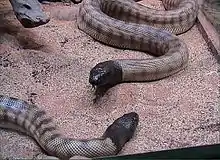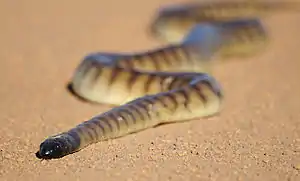Black-headed python
The black-headed python (Aspidites melanocephalus)[3] is a species of snake in the Pythonidae (the python family). The species is native to Australia. No subspecies are currently recognized.
| Black-headed python | |
|---|---|
 | |
| Scientific classification | |
| Kingdom: | Animalia |
| Phylum: | Chordata |
| Class: | Reptilia |
| Order: | Squamata |
| Suborder: | Serpentes |
| Family: | Pythonidae |
| Genus: | Aspidites |
| Species: | A. melanocephalus |
| Binomial name | |
| Aspidites melanocephalus (Krefft, 1864) | |
 | |
| Distribution of the black-headed python | |
| Synonyms | |
| |
Description


Adults typically grow to 1.5–2 m (4.9–6.6 ft) in total length,[5] but can grow to a maximum of 3.5 m (11 ft). The body is muscular with a flattened profile, while the tail tapers to a thin point.
The top of the head is covered by large, symmetrical scales. The dorsal scales, which are smooth and glossy, number 50-65 rows at midbody, while 315-355 ventral scales occur. The tail has 60-75 mainly single subcaudal scales and the anal scale is single. The posterior subcaudals tend to be divided, often irregularly.
The color pattern consists of shades of black, dark grey, brown, gold, and cream arranged in a striped or brindled pattern. The belly is light-colored, flecked with darker spots. The head is shiny black that also extends down the neck and throat for several inches.
Distribution and habitat
The species is found in Australia in the northern half of the country, excluding the very arid regions.[6] The type locality given is "Port Denison Bowen" Queensland, Australia.[2] It occurs in humid tropical to semiarid conditions.

Behaviour
These snakes are terrestrial and are often found in amongst rocks and loose debris. If disturbed, they hiss loudly, but are unlikely to bite unless hunting prey. They sometimes strike with a closed mouth, but generally can be handled easily. They are strong swimmers, but are almost never found in water. They are not venomous.
Feeding
The diet consists mainly of reptiles, including snakes, but they will eat mammals if available. Because black-headed pythons live in the desert, they heat up quicker and stay warmer for longer. This means they can eat more because they digest food quicker in warmer conditions. When ingesting large prey, this species positions one or two coils just ahead of its distended mouth and by constriction makes the task of swallowing easier.
Reproduction
Oviparous, females lay five to 10 eggs per clutch. The females stay coiled about the eggs and incubate them until they hatch, which is usually after 2–3 months. The young take small prey as soon as 2 days after hatching. Immature individuals are vulnerable to predation, including cannibalism. Adults have no natural predators other than dingos and humans.
Captivity
Due to its docile nature and striking color pattern, this species has become very desirable as an exotic pet. It is bred in captivity and can be relatively easily obtained, but does command a high price. As they can be muscular snakes and reach a fairly substantial size, prospective owners should consider a suitable enclosure, as well as temperature and feeding requirements.
In human culture
These snakes are mentioned in, or play a central role in, the stories of the Indigenous Australians Dreamtime tradition.
References
- Shea, G.; Ellis, R.; Wilson, S. (2017). "Aspidites melanocephalus". IUCN Red List of Threatened Species. 2017. Retrieved 9 November 2020.
- McDiarmid RW, Campbell JA, Touré T. 1999. Snake Species of the World: A Taxonomic and Geographic Reference, Volume 1. Herpetologists' League. 511 pp. ISBN 1-893777-00-6 (series). ISBN 1-893777-01-4 (volume).
- Mehrtens JM. 1987. Living Snakes of the World in Color. New York: Sterling Publishers. 480 pp. ISBN 0-8069-6460-X.
- Krefft, G. (1869). The snakes of Australia : an illustrated and descriptive catalogue of all known species.
- Burnie D, Wilson DE. 2001. Animal. Dorling Kindersley. 624 pp. ISBN 0-7894-7764-5.
- "Black Headed Python Care Sheet". REptile Range. Retrieved 28 January 2021.
Further reading
- Boulenger, G.A. 1893. Catalogue of the Snakes in the British Museum (Natural History). Volume I., Containing the Families...Boidæ... Trustees of the British Museum (Natural History). (Taylor and Francis, Printers.) London. xiii + 448 pp. + Plates I.- XXVIII. (Aspidites melanocephalus, p. 91.)
- Krefft, G. 1864. Description of Aspidiotes melanocephalus, a New Snake from Port Denison, N.E. Australia. Proc. Zool. Soc. London 1864: 20-22.
External links
| Wikimedia Commons has media related to Aspidites melanocephalus. |
- Black-headed Python video Accessed 30 June 2013
- Aspidites melanocephalus at the Reptarium.cz Reptile Database. Accessed 19 September 2007.
- The Creation Story of the Wardaman People at Renewing Women's Business. Accessed 19 September 2007.
- Black-Headed Python at Zoos Victoria. Accessed 19 September 2007.
- Aspidites melanocephalus at Pete Python Pete Reptiles. Accessed 19 September 2007.
